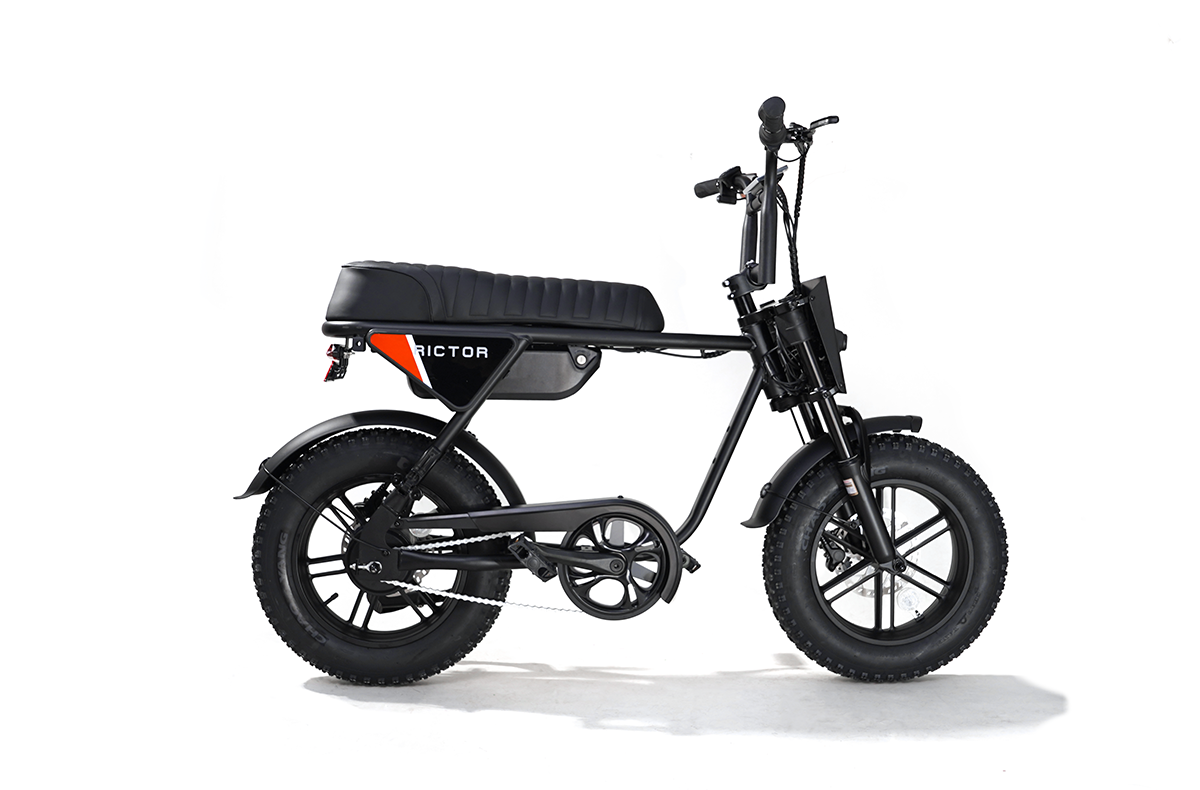
Ebike Terms Every Rider Should Know
Planning to buy electric bikes? Why not start by familiarizing yourself with the essential E-bike terminology?
Understanding these terms will help clarify your purchasing decisions and ensure you know exactly what you’re looking for.
If you're after a bike that looks vintage and has some smart features, check out the Rictor K1.
It’s got app unlock for easy access, real-time updates on your bike’s status, and a keyless start for a quick getaway.
Plus, you can track your rides with the riding footprint feature.
If you want a bike that makes life a little easier and more fun, the K1 is definitely worth a look.
Electric Bike Classfication
E-bikes are categorized into three primary classes based on their design and functionality, each with distinct features and legal implications:
Class 1
These E-bikes provide pedal assistance only, meaning the motor engages only when the rider is pedaling.
The assistance stops when the bike reaches a speed of 20 mph (32 km/h).
Class 1 E-bikes are widely accepted on bike paths and lanes, making them suitable for casual riders and commuters alike.
Class 2
Unlike Class 1, Class 2 E-bikes come equipped with a throttle, allowing riders to propel the bike without pedaling.
The motor, like Class 1, also cuts off at 20 mph. While these bikes offer convenience, especially for those who may not want to pedal continuously, some regions restrict their access to bike paths due to the throttle feature.
Class 3
These high-performance E-bikes provide pedal assistance up to 28 mph (45 km/h).
Class 3 E-bikes are designed for speed and efficiency, often featuring robust components suitable for longer commutes.
However, they may have specific regulations regarding where they can be ridden, requiring riders to adhere to local laws.

SEE ALSO How Fast Can E-Bikes with Different Voltages Go?
Motor Types
The motor is a fundamental part of any E-bike, determining its performance and riding experience.
E-bike motors can be categorized into three main types, each with its own advantages and drawbacks:
Mid-drive Motors
Positioned at the bike’s bottom bracket, mid-drive motors provide power directly to the bike’s chain.
This setup results in efficient energy transfer and better handling on hills.
Mid-drive motors are generally lighter, contribute to a lower center of gravity, and offer a more natural pedaling feel.
However, they can place more strain on the bike’s transmission and may require more maintenance.
Hub Motors
These motors are integrated into the wheel hub and can be found in both front and rear wheels.
Hub motors are straightforward to install and often require less maintenance than mid-drive motors.
They provide a smooth ride and can be either geared or gearless.
Geared hub motors tend to have better torque and acceleration, making them ideal for hilly terrains, while gearless motors are usually quieter and more durable.
However, hub motors can lead to a heavier wheel, which may affect handling.
Belt Drive Motors
A less common option, belt drive motors use a belt system instead of a chain. They are known for being quieter and requiring less maintenance. However, they can be more expensive and are not as widely available.

Battery Specifications
The battery is another critical component of E-bikes, significantly affecting performance and range. Key terms related to E-bike batteries include:
-
Battery Types: The most common types of batteries used in E-bikes are lithium-ion, lead-acid, and nickel-hydride.
- Lithium-ion batteries are lightweight, have a high energy density, and offer longer life cycles, making them the most popular choice for modern E-bikes.
- Lead-acid batteries are heavier and bulkier but are generally cheaper. They are more commonly found in lower-end models.
- Nickel-hydride batteries offer a middle ground in terms of weight and performance but have largely been replaced by lithium-ion options.
Important Parameters:
-
Torque (Nm): Torque is the measure of rotational force. Higher torque ratings indicate better performance on inclines, making them ideal for hilly terrains.
-
Power (Watts): This indicates the motor's output and directly affects how quickly and efficiently the bike can accelerate.
-
Voltage (V): The voltage rating of a battery impacts its efficiency and the speed at which power can be delivered to the motor. Higher voltage systems can offer better performance.
-
Amp-hours (Ah): This measures the battery's capacity, indicating how much energy it can store. A higher Ah rating typically means a longer range.
-
Watt-hours (Wh): This combines the voltage and amp-hours to give a better understanding of overall energy capacity.
-
Range: The range of an E-bike refers to how far it can travel on a single charge. Factors influencing range include battery capacity, terrain, rider weight, and riding conditions. Typical ranges vary from 20 to 100 miles.
-
Charge Cycles: This term refers to the number of complete discharge and recharge cycles a battery can undergo before its capacity significantly diminishes. Lithium-ion batteries typically last for 500 to 1,000 charge cycles, depending on usage and care.

E-bike Components
The various components of an E-bike contribute to its overall functionality and performance:
-
Frame: The frame is the backbone of the bike, influencing its weight, strength, and ride quality. Common materials include aluminum for lightweight durability and steel for strength.
-
Wheels: Wheel size can impact ride quality and handling. Larger wheels, such as 29 inches, can roll over obstacles more easily, while smaller wheels may offer better maneuverability.
-
Brakes: E-bikes typically use either mechanical or hydraulic brakes. Hydraulic brakes offer superior stopping power and modulation, while mechanical brakes are generally easier to maintain.
-
Gears: The type of gearing system affects the bike’s performance on various terrains. E-bikes may feature single-speed, multi-speed, or automatic shifting systems, allowing riders to adapt to different riding conditions.
Electric Bike Sensors
Electric bike sensors play a crucial role in optimizing the performance and functionality of electric bicycles. These sensors detect various parameters and provide feedback to the motor and control systems, ensuring a smooth and efficient ride. Here are the key types of sensors found in E-bikes:
1. Torque Sensors
Torque sensors measure the amount of force applied to the pedals.
They provide real-time data on how hard the rider is pedaling, allowing the motor to adjust its power output accordingly.
This results in a more responsive and natural riding experience, as the motor can deliver assistance based on the rider's effort.
Higher torque readings prompt the motor to provide more power, which is especially useful when climbing hills or accelerating.
2. Cadence Sensors
Cadence sensors track the speed at which the rider is pedaling, measured in revolutions per minute (RPM).
This data allows the E-bike's control system to manage the motor's output more effectively.
By integrating cadence information, the bike can optimize assistance based on how quickly the rider is pedaling, ensuring a smoother transition between different levels of support.
3. Speed Sensors
Speed sensors measure the bike's current speed, providing essential data for the motor's operation.
They help the E-bike's control system regulate assistance, ensuring it does not exceed legal speed limits (typically 20 mph or 28 mph depending on the class).
4. Brake Sensors
Brake sensors detect when the rider applies the brakes.
Upon activation, these sensors signal the motor to cut off power, allowing for a safer braking experience.
This feature ensures that the motor does not continue to assist while the rider is slowing down, which could lead to loss of control.
5. Battery Management Sensors
These sensors monitor the battery's state of charge, temperature, and overall health.
By providing real-time feedback on battery performance, they help optimize power usage and prolong battery life.
This information is crucial for ensuring that riders have sufficient range for their journeys and can plan charging accordingly.
Conclusion
Electric bike terminology helps you make informed decisions when choosing the right ride for you.
If you're ready to experience the blend of style and smart features, the Rictor K1 is a great option to consider for your next adventure!
FAQs
What is the average lifespan of an E-bike battery?
The average lifespan of an E-bike battery is typically between 3 to 5 years, depending on usage and care. Regularly charging and properly maintaining the battery can extend its life.
Can I ride an E-bike in the rain?
Yes, most E-bikes are designed to be weather-resistant, but it’s still wise to avoid heavy rain when possible. Always check the manufacturer's guidelines for specific water resistance ratings.
How do I maintain my E-bike?
Regular maintenance includes checking tire pressure, cleaning the chain, inspecting brakes, and ensuring the battery is charged correctly. It’s also good to take it to a bike shop for a tune-up at least once a year.
💡 Explore More Here!
- Should You Buy Ebike from Amazon? Not a Bad Idea, But I Will Choose RICTOR!
- Riding in Wet Weather? Be careful, it can damage your bike!
- The RICTOR K1 is the BEST ALL AROUND EBike Under $2,500!
- Are e-bikes waterproof? the truth might surprise you!we still have owesome recommendation
- Your handy checklist for buying a new e-bike, don't miss your best bike



